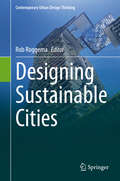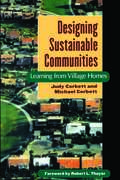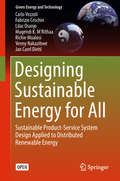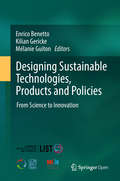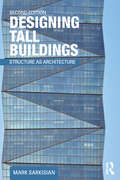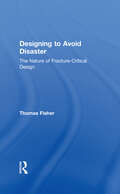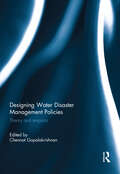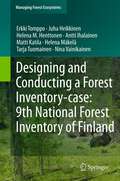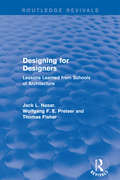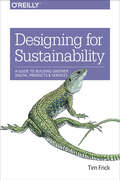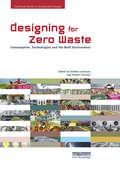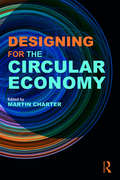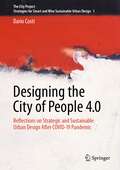- Table View
- List View
Designing Suburban Futures
by June WilliamsonSuburbs deserve a better, more resilient future. June Williamson shows that suburbs aren't destined to remain filled with strip malls and excess parking lots; they can be reinvigorated through inventive design. Drawing on award-winning design ideas for revitalizing Long Island, she offers valuable models not only for U. S. suburbs, but also those emerging elsewhere with global urbanization. Williamson argues that suburbia has historically been a site of great experimentation and is currently primed for exciting changes. Today, dead malls, aging office parks, and blighted apartment complexes are being retrofitted into walkable, sustainable communities. Williamson shows how to expand this trend, highlighting promising design strategies and tactics. She provides a broad vision of suburban reform based on the best schemes submitted in Long Island's highly successful "Build a Better Burb" competition. Many of the design ideas and plans operate at a regional scale, tackling systems such as transit, aquifer protection, and power generation. While some seek to fundamentally transform development patterns, others work with existing infrastructure to create mixed-use, shared networks. Designing Suburban Futures offers concrete but visionary strategies to take the sprawl out of suburbia, creating a vibrant, new suburban form. It will be especially useful for urban designers, architects, landscape architects, land use planners, local policymakers and NGOs, citizen activists, students of urban design, planning, architecture, and landscape architecture.
Designing Sustainability for All: The Design of Sustainable Product-Service Systems Applied to Distributed Economies (Lecture Notes in Mechanical Engineering)
by Carlo Vezzoli Cindy Kohtala Brenda Garcia ParraThis open access book introduces design for Sustainable Product-Service Systems (S.PSS) and for Sustainable Distributed Economies (S.DE). These are introduced as technical and operative tools for the development of a new generation of designers, responsible and capable of designing environmentally, socially and economically sustainable solutions, accessible to all. The book provides a comprehensive framework and also practical tools to support the system design for sustainability process. It overviews methodologies, tools and strategies for Sustainable PSS design applied to Distributed Economies (DE) and provides strategies and design guidelines. All of these are highlighted and expanded upon with international case studies.
Designing Sustainable Cities (Contemporary Urban Design Thinking)
by Rob RoggemaThis book emphasizes new ways of designing for a sustainable city and urban environment. From several angles the future of our urbanism is illuminated. From a philosophical point of view, the city is seen as an organism, following complex ecosystemic principles, shining light on indigenous perspectives to become beneficial for sustainable design and core questions are asked whether current architectural practice is really sustainable. Simultaneously concrete practices are presented for cities in transformation, focusing on green infrastructure, smart city principles and health.
Designing Sustainable Communities: Learning From Village Homes
by Robert L. Thayer Michael Corbett Judy CorbettThe movement toward creating more sustainable communities has been growing for decades, and in recent years has gained new prominence with the increasing visibility of planning approaches such as the New Urbanism. Yet there are few examples of successful and time-tested sustainable communities.Village Homes outside of Davis, California offers one such example. Built between 1975 and 1981 on 60 acres of land, it offers unique features including extensive common areas and green space; community gardens, orchards, and vineyards; narrow streets; pedestrian and bike paths; solar homes; and an innovative ecological drainage system. Authors Judy and Michael Corbett were intimately involved with the design, development, and building of Village Homes, and have resided there since 1977.In Designing Sustainable Communities, they examine the history of the sustainable community movement and discuss how Village Homes fits into the context of that movement. They offer an inside look at the development of the project from start to finish, describing how the project came about, obstacles that needed to be overcome, design approaches they took, problems that were encountered and how those problems were solved, and changes that have occurred over the years. In addition, they compare Village Homes with other communities and developments across the country, and discuss the future prospects for the continued growth of the sustainable communities movement.The book offers detailed information on a holistic approach to designing and building successful communities. It represents an invaluable guide for professionals and students involved with planning, architecture, development, and landscape architecture, and for anyone interested increating more sustainable communities.
Designing Sustainable Energy for All: Sustainable Product-service System Design Applied To Distributed Renewable Energy (Green Energy and Technology)
by Jan Carel Diehl Fabrizio Ceschin Carlo Vezzoli Lilac Osanjo Mugendi K. M’Rithaa Richie Moalosi Venny NakazibweThis open access book addresses the issue of diffusing sustainable energy access inlow- and middle-income contexts.Access to energy is one of the greatest challenges for many people living in low-income and developing contexts, as around 1.4 billion people lack access to electricity.Distributed Renewable Energy systems (DRE) are considered a promising approachto address this challenge and provide energy access to all. However, even if promising,the implementation of DRE systems is not always straightforward.The book analyses, discusses and classifies the promising Sustainable Product-ServiceSystem (S.PSS) business models to deliver Distributed Renewable Energy systems in aneffective, efficient and sustainable way. Its message is supported with cases studies andexamples, discussing the economic, environmental and socioethical benefits as wellas its limitations and barriers to its implementation. An innovative design approach isproposed and a set of design tools are supplied, enabling readers to create and developSustainable Product-Service System (S.PSS) solutions to deliver Distributed RenewableEnergy systems.Practical applications of the book’s design approach and tools by companies andpractitioners are discussed and the book will be of interest to readers in design, industry,governmental institutions, NGOs as well as researchers.
Designing Sustainable Factories: A Toolkit for the Assessment and Mitigation of Impact on the Landscape (Advances in Global Change Research #72)
by Lia MarchiEconomic constraints and lack of knowledge often prevent companies - especially small and medium enterprises - from harmonizing their facilities with the landscape. As a result, factories significantly impact the quality of our living environment, in terms of physical effects on the ecosystem, perceptual interferences with the surroundings, and disturbances on local communities. At both the design and maintenance stages, a set of appropriate tools can assist businesses in becoming more aware of their impacts and identifying possible mitigation strategies. The book presents an assessment tool and a library of inspiring design tactics for factories, with examples of the benefits and synergies for the environment, the scenery, the community, and the company itself. The purpose is to elicit more than a simple reflection about what a sustainable factory entails. It is rather to encourage and assist both businesses and designers in mitigating the impact of industrial facilities on the landscape as holistically as possible.
Designing Sustainable Futures: How to Imagine, Create, and Lead the Transition to a Better World
by Manuela Celi Joseph PressWe are in a decisive decade that demands more inspired and informed practitioners who can use positive futures to rebalance the present. The book you hold seeks to be a thought‑provoking approach to imagine, create, and lead the journey to a more sustainable world – where a spectrum of choices, including regenerative practices, await conscientious citizens, companies, and communities.With this objective, and to help reverse the megatrends of economic disparity, social injustice, and climate change, the Institute for the Future (IFTF) and the Design Department of the Politecnico di Milano came together to prototype an approach to prepare all practitioners who seek to leverage the future to infuse our present with more impact and agency.Guided by global experts and inspired by a growing network of future‑makers, the authors share essential insights from this emerging landscape, offering thought‑provoking theory, innovative experiments, real‑world experiences, and practitioner stories. We draw insight and inspiration from many contemporary theories and practices, including strategic foresight, experiential futures, speculative design, design fiction, systems design, participatory design, and transformative leadership, and an emerging entry with genAI‑augmented design.Regardless of whether you have a design or management background, or want to create a for‑profit or non‑profit, this book enables professionals across industries, as well as students preparing for a career in strategy, innovation, or transformation, the knowledge, skills, and confidence to strengthen resilience and guide the transition to the more sustainable practices of a better world.
Designing Sustainable Technologies, Products and Policies: From Science To Innovation
by Enrico Benetto Kilian Gericke Mélanie GuitonThis open access book provides insight into the implementation of Life Cycle approaches along the entire business value chain, supporting environmental, social and economic sustainability related to the development of industrial technologies, products, services and policies; and the development and management of smart agricultural systems, smart mobility systems, urban infrastructures and energy for the built environment. The book is based on papers presented at the 8th International Life Cycle Management Conference that took place from September 3-6, 2017 in Luxembourg, and which was organized by the Luxembourg Institute of Science and Technology (LIST) and the University of Luxembourg in the framework of the LCM Conference Series.
Designing Tall Buildings: Structure as Architecture
by Mark SarkisianThis second edition of Designing Tall Buildings, an accessible reference to guide you through the fundamental principles of designing high-rises, features two new chapters, additional sections, 400 images, project examples, and updated US and international codes. Each chapter focuses on a theme central to tall-building design, giving a comprehensive overview of the related architecture and structural engineering concepts. Author Mark Sarkisian, PE, SE, LEED® AP BD+C, provides clear definitions of technical terms and introduces important equations, gradually developing your knowledge. Projects drawn from SOM’s vast portfolio of built high-rises, many of which Sarkisian engineered, demonstrate these concepts. This book advises you to consider the influence of a particular site's geology, wind conditions, and seismicity. Using this contextual knowledge and analysis, you can determine what types of structural solutions are best suited for a tower on that site. You can then conceptualize and devise efficient structural systems that are not only safe, but also constructible and economical. Sarkisian also addresses the influence of nature in design, urging you to integrate structure and architecture for buildings of superior performance, sustainability, and aesthetic excellence.
Designing Therapeutic Environments: Social and Cultural Practice for Health and Well-Being
by Bruno Marques Jacqueline McIntoshThis book draws on the relationship between culture and the environment and its connection with health and well-being. Therapeutic environments are settings that comprise the physical, ecological, psychological, spiritual and social environments associated with treatment and healing. Throughout the chapters, the understanding of therapeutic environments is broadened through the exploration of specific Indigenous cultural and social dimensions. Case studies comprise a combination of research papers regarding the theoretical and conceptual underpinnings of therapeutic environments and their application following traditional methods. This book contributes to the expanding body of knowledge focusing on the role of therapeutic environments and their role in shaping health and well-being through the development of new research methods.This book is essential for practitioners, scholars and students in architecture, landscape architecture, interior architecture, urban design, planning, geography, building science, public health and environmental engineering.
Designing To Avoid Disaster: The Nature of Fracture-Critical Design
by Thomas FisherRecent catastrophic events, such as the I-35W bridge collapse, New Orleans flooding, the BP oil spill, Port au Prince's destruction by earthquake, Fukushima nuclear plant's devastation by tsunami, the Wall Street investment bank failures, and the housing foreclosure epidemic and the collapse of housing prices, all stem from what author Thomas Fisher calls fracture-critical design. This is design in which structures and systems have so little redundancy and so much interconnectedness and misguided efficiency that they fail completely if any one part does not perform as intended. If we, as architects, planners, engineers, and citizens are to predict and prepare for the next disaster, we need to recognize this error in our thinking and to understand how design thinking provides us with a way to anticipate unintended failures and increase the resiliency of the world in which we live. In Designing to Avoid Disaster, the author discusses the context and cultural assumptions that have led to a number of disasters worldwide, describing the nature of fracture-critical design and why it has become so prevalent. He traces the impact of fracture-critical thinking on everything from our economy and politics to our educational and infrastructure systems to the communities, buildings, and products we inhabit and use everyday. And he shows how the natural environment and human population itself have both begun to move on a path toward a fracture-critical collapse that we need to do everything possible to avoid. We designed our way to such disasters and we can design our way out of them, with a number of possible solutions that Fisher provides.
Designing Water Disaster Management Policies: Theory and Empirics
by Chennat GopalakrishnanThis book represents a landmark effort to probe and analyze the theory and empirics of designing water disaster management policies. It consists of seven chapters that examine, in-depth and comprehensively, issues that are central to crafting effective policies for water disaster management. The author uses historical surveys, institutional analysis, econometric investigations, empirical case studies, and conceptual-theoretical discussions to clarify and illuminate the complex policy process.The specific topics studied in this book include a review and analysis of key policy areas and research priority areas associated with water disaster management, community participation in disaster risk reduction, the economics and politics of ‘Green’ flood control, probabilistic flood forecasting for flood risk management, polycentric governance and flood risk management, drought management with the aid of dynamic inter-generational preferences, and how social resilience can inform SA/SIA for adaptive planning for climate change in vulnerable areas.A unique feature of this book is its analysis of the causes and consequences of water disasters and efforts to address them successfully through policy-rich, cross-disciplinary and transnational papers. This book is designed to help enrich the sparse discourse on water disaster management policies and galvanize water professionals to craft creative solutions to tackle water disasters efficiently, equitably, and sustainably. This book should also be of considerable use to disaster management professionals, in general, and natural resource policy analysts.This book was published as a special issue of the Journal of Natural Resource Policy Research.
Designing Wind Turbines: Engineering and Manufacturing Process in the Industrial Context (Synthesis Lectures on Renewable Energy Technologies)
by Michael Beyer Uwe RitschelDesigning a wind turbine is an interdisciplinary process that requires an understanding of challenges for all parties involved. The authors deliver an effective and economic way to organize such a design by respecting all the challenges involved. The book provides such insight by utilizing specific examples of existing modern designs. Detailed descriptions and explanations are given for those components of the wind turbine that are normally developed by the so-called original equipment manufacturers (OEM) of a particular type. The OEM needs to have full knowledge of the complete system that consists of all parts being rotor blades, nacelle, drive train, tower, and foundation including the dynamic properties and the response to the controller action. This full knowledge is called system competence. For a wind turbine the drive train is the most important system. It consists of many components like shafts, bearings, gearbox, and generator for a wind turbine with a gear box; in systems without a gearbox a large generator has to be integrated into the drive train.
Designing Zero Carbon Buildings Using Dynamic Simulation Methods
by Ljubomir JankovicIn addition to the application of fundamental principles that lead to a structured method for zero carbon design of buildings, this considerably expanded second edition includes new advanced topics on multi-objective optimisation; reverse modelling; reduction of the simulation performance gap; predictive control; nature-inspired emergent simulation leading to sketches that become ‘alive’; and an alternative economics for achieving the sustainability paradigm. The book features student design work from a Master’s programme run by the author, and their design speculation for a human settlement on Mars. Tasks for simple simulation experiments are available for the majority of topics, providing the material for classroom exercise and giving the reader an easy introduction into the field. Extended new case studies of zero carbon buildings are featured in the book, including schemes from Japan, China, Germany, Denmark and the UK, and provide the reader with an enhanced design toolbox to stimulate their own design thinking.
Designing Zero Carbon Buildings: Embodied and Operational Emissions in Achieving True Zero
by Ljubomir JankovicIn this significantly revised third edition, Designing Zero Carbon Buildings combines embodied and operational emissions into a structured approach for achieving zero emissions by a specific year with certainty.Simulation and quantitative methods are introduced in parallel with analogue scale models to demonstrate how things work in buildings. Where equations are provided, this is also explained with common analogue objects, pictures, and narratives. A Zero Equation introduced in this book is not only explained as an equation but also as an analogy with a jam jar and spoons, making the book accessible for a range of audiences. Tasks for simple experiments, exercises, discussion questions, and summaries of design principles are provided in closing lines of chapters.This book introduces new case studies, in addition to an updated case study of the Birmingham Zero Carbon House, applying embodied and operational emissions to assess their status using the Zero Equation. The approach introduced brings about a sense of realism into what true zero emissions mean. Written for students, educators, architects, engineers, modellers, practising designers, sustainability consultants, and others, it is a major positive step towards design thinking that makes achieving zero carbon emissions a reality.
Designing a Sustainable Financial System: Development Goals and Socio-Ecological Responsibility (Palgrave Studies in Sustainable Business In Association with Future Earth)
by Thomas Walker Stéfanie D. Kibsey Rohan CrichtonThis edited collection brings together leading theoretical and applied research with the intent to design a sustainable global financial future. The contributors argue that our world cannot move toward sustainability, address climate change, reverse environmental degradation, and improve human well-being without aligning the financial system with sustainable development goals like those outlined by the United Nations. Such a system would: a) be environmentally and socially responsible; b) align with planetary boundaries; c) manage natural resources sustainably; d) avoid doing more harm than good; and e) be resilient and adaptable to changing conditions. The overarching theme in this collection of chapters is a response to the worldwide, supranational sustainable finance discussions about how we can transition to a new socio-ecological system where finance, human well-being, and planetary health are recognized as being highly intertwined.
Designing and Conducting a Forest Inventory - case: 9th National Forest Inventory of Finland
by Matti Katila Juha Heikkinen Helena M. Henttonen Tarja Tuomainen Nina Vainikainen Antti Ihalainen Helena Mäkelä Erkki TomppoThis book demonstrates in detail all phases of the 9th National Forest Inventory of Finland (1996-2003): the planning of the sampling design, measurements, estimation methods and results. The inventory knowledge accumulated during almost one hundred years is consolidated in the book. The purpose of the numerous examples of results is to demonstrate the diversity of the estimates and content of a national forest inventory. The most recent results include the assessment of the indicators describing the biodiversity of forests. The Finnish NFI has been and is a model for many countries worldwide. The methods and results of the book are set in the international context and are applicable globally. The book provides a valuable information source for countries, institutions and researchers planning own inventories as well as modifying the existing ones, or seeking the applicable definitions and estimation methods to use in their own inventories.
Designing for Designers: Lessons Learned from Schools of Architecture (Routledge Revivals)
by Thomas Fisher Wolfgang F. Preiser Jack NasarFirst published in 2007, this book examines the designs of seventeen architecture and design schools and answers questions such as: How has architectural education evolved and what is its future? Are architectural schools discernible types of designs and what are their effects on those who experience them? What lessons can be learned from evaluations of recently completed school buildings and what guidance do they provide for the design of future ones? Included in the multiple approaches to evaluation are examinations of the history of architectural education and building form; typologies of school for architecture; and the systematic user evaluations of the aesthetics, function, and technology which reveal the strengths to encourage and weaknesses to avoid in future designs. While offering specific guidelines for schools of design, it also includes findings that extend beyond the walls of design schools and can be applied to everything from the interiors of educational and campus buildings to planning offices and gathering places to build communities. This book will make readers more aware of problems in architectural interiors and suggest ways to make interiors work better for the building occupants.
Designing for Longevity: Expert Strategies for Creating Long-Lasting Products
by Louise Møller Haase Linda Nhu LaursenProduct longevity is one of the cornerstones in the transition towards a more sustainable society and a key driver for the circular economy model. This book provides designers, developers, and creators with five distinctive expert strategies, detailed case studies, action guides and worksheets that support both beginning and advanced design practitioners in creating new product concepts with long-lasting strategic fits. Designing for Longevity shows how expert design teams create original and long-lasting product concepts from the early development phase. It focuses on integrating business knowledge, market conditions, company capabilities, technical possibilities and user needs into product concepts to make better strategic decisions. It demonstrates how, for products to be durable, designers must create a long-lasting strategic fit for the customer, company, and market. Key case studies of products such as Bang & Olufsen’s A9, LEGO Ninjago and Friends and Coloplasts’ Sensura Mio, among others, offer readers inspiration, guidance and real-world insights from design teams showing how the strategies can be applied in practice. Action guidelines and worksheets encourage broad, analytical problem-solving to identify and think through challenges at the early concept stage. Beautifully designed and illustrated in full colour throughout, this book combines original research and the hands-on tools and strategies that design practitioners need to create useful, sustainable products.
Designing for Sustainability: A Guide to Building Greener Digital Products and Services
by Tim FrickPixels use electricity, and a lot of it. If the Internet were a country, it would be the sixth largest in terms of electricity use. That’s because today’s average web page has surpassed two megabytes in size, leading to slow load times, frustrated users, and a lot of wasted energy. With this practical guide, your web design team will learn how to apply sustainability principles for creating speedy, user-friendly, and energy-efficient digital products and services.Author Tim Frick introduces a web design framework that focuses on four key areas where these principles can make a difference: content strategy, performance optimization, design and user experience, and green hosting. You’ll discover how to provide users with a streamlined experience, while reducing the environmental impact of your products and services.Learn why 90% of the data that ever existed was created in the last yearUse sustainability principles to innovate, reduce waste, and function more efficientlyExplore green hosting, sustainable business practices, and lean/agile workflowsPut the right things in front of users at precisely the moment they need them—and nothing moreIncrease site search engine visibility, streamline user experience, and make streaming video more efficientUse Action Items to explore concepts outlined in each chapter
Designing for Zero Waste: Consumption, Technologies and the Built Environment
by Steffen Lehmann Robert CrockerDesigning for Zero Waste is a timely, topical and necessary publication. Materials and resources are being depleted at an accelerating speed and rising consumption trends across the globe have placed material efficiency, waste reduction and recycling at the centre of many government policy agendas, giving them an unprecedented urgency. While there has been a considerable literature addressing consumption and waste reduction from different disciplinary perspectives, the complex nature of the problem requires an increasing degree of interdisciplinarity. Resource recovery and the optimisation of material flow can only be achieved alongside and through behaviour change to reduce the creation of material waste and wasteful consumption. This book aims to develop a more robust understanding of the links between lifestyle, consumption, technologies and urban development.
Designing for the Circular Economy
by Martin CharterThe circular economy describes a world in which reuse through repair, reconditioning and refurbishment is the prevailing social and economic model. The business opportunities are huge but developing product and service offerings and achieving competitive advantage means rethinking your business model from early creativity and design processes, through marketing and communication to pricing and supply. Designing for the Circular Economy highlights and explores ‘state of the art’ research and industrial practice, highlighting CE as a source of: new business opportunities; radical business change; disruptive innovation; social change; and new consumer attitudes. The thirty-four chapters provide a comprehensive overview of issues related to product circularity from policy through to design and development. Chapters are designed to be easy to digest and include numerous examples. An important feature of the book is the case studies section that covers a diverse range of topics related to CE, business models and design and development in sectors ranging from construction to retail, clothing, technology and manufacturing. Designing for the Circular Economy will inform and educate any companies seeking to move their business models towards these emerging models of sustainability; organizations already working in the circular economy can benchmark their current activities and draw inspiration from new applications and an understanding of the changing social and political context. This book will appeal to both academia and business with an interest in CE issues related to products, innovation and new business models.
Designing for the Climate Emergency: A Guide for Architecture Students
by Sofie Pelsmakers Aidan Hoggard Urszula Kozminska Elizabeth DonovanWe are in a climate emergency. Architects must be part of the radical change needed. This book guides architecture student to create truly sustainable designs. Demonstrating holistic design approaches through 10 key themes, it guides students through the different stages of the design process in five illustrated chapters. Reflecting the years of study, it provides step-changes towards eventual architecture practice. Unique features include key checklists, case studies, student examples and an extensive glossary.
Designing the City of People 4.0: Reflections on strategic and sustainable urban design after Covid-19 pandemic (The City Project #1)
by Dario CostiThis book collects a set of reflections concerning the planning of contemporary cities by urban design, with a special emphasis on some needs and shortcomings emerged during the coronavirus pandemic. With the ultimate goal of designing accessible, inclusive and welcoming green cities, it discusses the urgent need for new systems of public spaces across the city, together with alternative solutions for individual mobility (especially slow mobility) and social interaction. It is intended for a broad readership, including designers, engineers, architects, social scientists, stakeholders, and public administrators, who deal with various aspects of the realization of the City 4.0.
Designing the Compassionate City: Creating Places Where People Thrive
by Jenny DonovanDesigning the Compassionate City outlines an approach to urban design that is centred on an explicit recognition of the inherent dignity of all people. It suggests that whether we thrive or decline—as individuals or as a community—is dependent on our ability to fulfil the full spectrum of our needs. This book considers how our surroundings help or hinder us from meeting these needs by influencing both what we can do and what we want to do; either inspiring us to lead healthy, fulfilled lives or consigning us to diminished lives tainted by ill health and unfulfilled potential. Designing the Compassionate City looks at how those who participate in designing towns and cities can collaborate with those who live in them to create places that help people to accumulate the life lessons, experiences and achievements, as well as forge the connections to meet their needs, to thrive and to fulfil their potential. The book explores a number of inspiring case studies that have sought to meet this challenge and examines what has worked and what hasn’t. From this, some conclusions are drawn about how we can all participate in creating places that leave a lasting legacy of empowerment and commitment to nurturing one another. It is essential reading for students and practitioners designing happier, healthier places.


